Aston Martin DB5
| Aston Martin DB5 | |
|---|---|
_(cropped).jpg) | |
| Overview | |
| Manufacturer | Aston Martin |
| Production |
1963–1965 1,059 produced[1] |
| Body and chassis | |
| Class | Grand tourer (S) |
| Body style |
2-door 2+2 coupé 2-door convertible (123) 2-door shooting brake (13)[2] |
| Layout | FR layout |
| Doors | 2 |
| Powertrain | |
| Engine |
DOHC Straight six, 3995 cc, 282 bhp @ 5500 rpm 280 lbs-ft @ 4500 rpm |
| Transmission | 5-speed ZF box or optional Borg-Warner 3-speed automatic |
| Dimensions | |
| Length | 4.57 metres (179.9 in) |
| Width | 1.68 metres (66.1 in) |
| Chronology | |
| Predecessor | Aston Martin DB4 |
| Successor | Aston Martin DB6 |
The Aston Martin DB5 is a British luxury grand tourer that was made by Aston Martin and designed by the Italian coachbuilder Carrozzeria Touring Superleggera. Released in 1963, it was an evolution of the final series of DB4. The DB series was named honouring Sir David Brown (the head of Aston Martin from 1947 to 1972). Although not the first, the DB5 is famous for being the most recognised cinematic James Bond car, first appearing in Goldfinger (1964).[3]
Design
The principal differences between the DB4 Series V and the DB5 are the all-aluminium engine, enlarged from 3.7 L to 4.0 L; a new robust ZF five-speed transmission (except for some of the very first DB5s);[4] and three SU carburettors. This engine, producing 282 bhp (210 kW), which propelled the car to 145 mph (233 km/h), available on the Vantage (high powered) version of the DB4 since March 1962, became the standard Aston Martin power unit with the launch in September 1963 of the DB5.[5]
Standard equipment on the DB5 included reclining seats, wool pile carpets, electric windows, twin fuel tanks, chrome wire wheels, oil cooler, magnesium-alloy body built to superleggera patent technique, full leather trim in the cabin and even a fire extinguisher. All models have two doors and are of a 2+2 configuration.
Like the DB4, the DB5 used a live rear axle[6] At the beginning, the original four-speed manual (with optional overdrive) was standard fitment, but it was soon dropped in favour of the ZF five-speed.[4] A three-speed Borg-Warner DG automatic transmission was available as well.[7] The automatic option was then changed to the Borg-Warner Model 8 shortly before the DB6 replaced the DB5.[5]
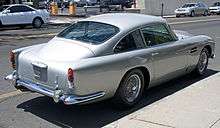
Specifications
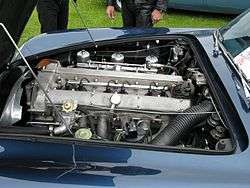
Standard coupé:[1]
- Engine: 3,995 cc (243.8 cu in) Inline-6
- Power: 282 bhp (210 kW) at 5,500 rpm (210) Net HP
- Torque: 288 lb·ft (390 N·m) at 3,850 rpm
- Weight: 1,502 kg (3,311 lb)
- Top Speed: 143 mph (230 km/h)[8]
- 0–60 mph (97 km/h) Acceleration: 8 s[8]
Variants
DB5 Vantage
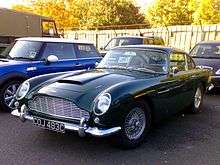
The high-performance DB5 Vantage was introduced in 1964 featuring three Weber twin-choke 45DCOE side-draft carburettors and revised camshaft profiles, delivering greater top-end performance at the expense of overall flexibility, especially as legendary Webers are renowned as 'full-throttle' devices. This engine produced 315 hp (235 kW). Only 65 DB5 Vantage coupés were built.
DB5 convertible
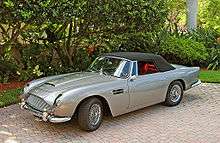
Just 123 convertible DB5s were produced (also with bodies by Touring), though they did not use the typical "Volante" name until 1965.[4] The convertible model was offered from 1963 through to 1965. Originally only 19 of the 123 DB5 Convertibles made were left-hand drive. 12 cars were originally fitted with a factory Vantage engine, and at least one further convertible was subsequently factory fitted with a DB6 specification Vantage engine. A rare factory option (actually fitted by Works Service prior to customer delivery) was a steel removable hard top.
From October 1965 to October 1966, Aston Martin used the last 37 of the Aston Martin DB5 chassis' to make another convertible model. These 37 cars were known as "Short Chassis" Volantes and were the first Aston Martins to hold the "Volante" name. Although calling it a "Short Chassis" is a bit of a misnomer as the "short" comes from comparing it to the subsequent DB6, which has a longer chassis. When compared to the DB5, it is not "short" but rather the same size, however these cars differ to the DB5 convertible models as they feature DB6 split front and rear bumpers and rear TR4 lights, as also used on the DB6.
DB5 shooting-brake
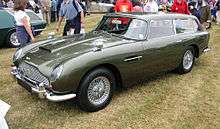
A prototype DB5 shooting-brake was custom produced by the factory for David Brown, an avid hunter and dog owner, and 11-12 more coupés were custom modified for Aston Martin by independent coachbuilder, Harold Radford.[9][10] The taillights used were Triumph units, and were also adopted for the succeeding DB6.
James Bond's DB5
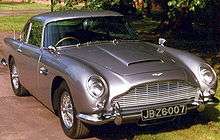
The Aston Martin DB5 is one of the most famous cars in the world thanks to Oscar-winning special effects expert John Stears, who created the deadly silver-birch DB5 for use by James Bond in Goldfinger (1964). Although Ian Fleming had placed Bond in a DB Mark III in the novel, the DB5 was the company's latest model when the film was being made.
The car used in the film was the original DB5 prototype, with another standard car used for stunts. To promote the film, the two DB5s were showcased at the 1964 New York World's Fair, and it was dubbed "the most famous car in the world",[11] and subsequently sales of the car rose.[12] In January 2006, one of these was auctioned in Arizona; the same car was originally bought in 1970 from the owner, Sir Anthony Bamford, by a Tennessee museum owner.[13] A car, mainly used for promoting the movie, is now located in the Louwman Museum, Netherlands.[14] The first DB5 prototype used in Goldfinger with the chassis number DP/216/1 was later stripped of its weaponry and gadgetry by Aston Martin and then resold. It was then retrofitted by subsequent owners with nonoriginal weaponry. The Chassis DP/216/1 DB5 was stolen in 1997 from its last owner in Florida and is currently still missing.[15]
Within the universe of James Bond, the same car (registration BMT 216A) was used again in the following film, Thunderball, a year later.
A different Aston Martin DB5 (registration BMT 214A) was used in the 1995 Bond film, GoldenEye, in the which the car is Bond's personal vehicle. Three different DB5s were used for filming. The BMT 214A also returned in Tomorrow Never Dies (1997) and was set to make a cameo appearance in the Scotland-set scenes in The World Is Not Enough (1999), but these were cut in the final edit. Yet another DB5 appeared in Casino Royale (2006), this one with Bahamian number plates and left-hand drive (where the previous British versions had been right-hand drive).
Another silver-birch DB5 with the original registration BMT 216A is used in the 23rd James Bond film, Skyfall, during the 50th anniversary of the release of the first James Bond film Dr. No.[16] In the film "M" (Judi Dench) describes the car as "not very comfortable". The DB5 is destroyed in the film's climactic finale. It is seen again in Spectre, firstly in Q's underground workshop in various stages of rebuild, and at the film's ending, fully rebuilt, with Bond driving away with it.
On 1 June 2010, RM Auctions announced the upcoming auction of a DB5 used in both Goldfinger and Thunderball. The owner (Jerry Lee, president/owner of WBEB Radio in Philadelphia, Pennsylvania) originally bought the car from the Aston Martin company in 1969. At the auction, the DB5 was sold for £2.6 million.[17]
Promotional items

With Goldfinger, Corgi Toys began its decades-long relationship with the Bond franchise: they produced a toy of the car, which became the biggest selling toy of 1964.[18] A highly detailed kit was also produced by Airfix between 1966 and 1970.[19]
A highly detailed 1:24 scale die-cast model with many working features was produced as a limited edition in 2006 for Casino Royale, by the Danbury Mint. In January 2011 a 1/8 scale model was released by part work magazine publisher GE Fabbri in the UK. Over 85 weekly parts, the model builds into one of the biggest 007 scale models to date, with working gadgets and lights.[20]
In popular culture
Although the DB5 is often credited as being the first car James Bond drives in the movies, it is in fact not. The first "Bond car" was a 1962 Sunbeam Alpine Series II used in the very first movie Dr. No. The DB5 is however unquestionably the most recognised cinematic James Bond car.[3] It was also used by actor Roger Moore, as he played a James Bond parody character in the film The Cannonball Run. Moore plays Seymour Goldfarb, Jr., a man who believes himself to be both Roger Moore and James Bond, who participates in a madcap, cross-country road race. The registration number BMT 216A, and the original bond car in its original dark red paintjob also appear in "The Noble Sportsman", a 1964 episode of "The Saint" TV series starring Roger Moore.
The 1983 reunion telefilm The Return of the Man from U.N.C.L.E.: The Fifteen Years Later Affair includes a brief cameo by George Lazenby as "JB", a white-tuxedoed British man shown driving an Aston Martin DB5, who assists Napoleon Solo during a car chase. "It's just like On Her Majesty's Secret Service," enthuses a female character at the conclusion of the cameo. This special came out in 1983, the same year as Octopussy and Never Say Never Again.
It appears in several video games such as 007 Racing, Driver San Francisco (Deluxe Edition), James Bond 007: Agent Under Fire, From Russia with Love, and James Bond 007: Blood Stone. The From Russia with Love movie was released in 1963, one year before Goldfinger (in which the DB5 used the first time), but the video game used the car.
It appeared in animated form in James Bond Jr. in the very first episode "The Beginning". In the episode it was able to transform into a plane and could be driven by remote control. The car was destroyed in a plane crash and its remains recycled into a red sports car, which the PAL VHS cover identifies as the "Aston Martin Super".
A version of the car appeared in Grand Theft Auto: London 1969, being called a "James Bomb".
Leonardo DiCaprio was seen driving one in Catch Me If You Can, imitating Bond (even down to the suit) in Goldfinger.
In 2003, it appears in the action comedy film Charlie's Angels: Full Throttle, driven by Bernie Mac's character, Jimmy Bosley. It is only seen once in which Bosley is driving a witness, Max Petroni (portrayed by Shia LaBeouf) to his mother's house, to be safe from the O'Grady Crime Syndicate.
The 2004 French spy comedy film, called Double Zéro (directed by Gérard Pirès) also showed a DB5. It can be seen once in the film, when the two main characters go to meet the parody of Q.
In 2011, an Aston Martin DB5 appeared in heavily stylized form as "Finn McMissile", a British secret agent voiced by Michael Caine in the 2011 Pixar film Cars 2. The car character was a homage to the Bond DB5 although has also been known to bear resemblance to the Volvo P1800, as used by the fictional British secret agent Simon Templar in The Saint.
In 2013, Grand Theft Auto V featured a car called the "JB 700" that heavily alluded to being a DB5, or was based on the DB5; specifically the one used by James Bond. Need for Speed: Most Wanted released a DLC named "Movie Legends" that featured the car.
The music video for the Usher song Burn, features a DB5. The exact same car with the same registration number appears a number of times in the short lived TV series Fastlane.
In the 2015 TV series Thunderbirds Are Go a DB5 can be seen as Lady Penelope gets into Fab 1 in the first episode Ring Of Fire.
See also
References
- 1 2 Wan, Mark (2005). "Aston Martin DB5 (1963)". AutoZine.org. Archived from the original on 5 October 2008.
- ↑ Cottingham, Tim (9 July 2008). "Aston Martin DB5 Shooting Brake by Harold Radford (1965–1967)". AstonMartins.com.
- 1 2 Copyright 1998–2011. "Aston Martin DB5 :: Q Branch :: MI6 :: The Home Of James Bond 007". MI6. Retrieved 27 January 2011.
- 1 2 3 Flammang, James M. (1994). Standard Catalog of Imported Cars, 1946-1990. Iola, WI: Krause Publications. p. 57. ISBN 0-87341-158-7.
- 1 2 "Used car test: 1964 Aston Martin DB5". Autocar. 129 (3777): 46–47. 4 July 1968.
- ↑ "Style Icon – Aston Martin DB5 | The Mitchelli – Modern Gentleman". themitchelli.com. Retrieved 3 September 2015.
- ↑ Mike Lawrence (1991). A to Z of Sports Cars. Bideford, Devon: Bay View Books. p. 36. ISBN 1-870979-81-8.
- 1 2 "Road Test #1992: Aston Martin DB5" (PDF). Autocar. reprinted in Works Torque, April 2006, p. 14. 18 September 1964. Archived from the original (PDF) on 16 October 2006.
- ↑ Peter Hingston (2008). The Enthusiasts' Guide to Buying a Classic British Sports Car. ISBN 0-906555-25-6.
- ↑ David Dowsey (2007). Aston Martin: Power, Beauty and Soul. Images Publishing. p. 101. ISBN 0-9578759-5-9.
- ↑ Pfeiffer & Worrall 1998, p. 33.
- ↑ Bouzerau 2006, pp. 110–111.
- ↑ "James Bond car sold for over m". BBC News. 21 January 2006. Retrieved 25 April 2010.
- ↑ "Louwman Museum Aston Martin". Louwman Museum. Archived from the original on 25 May 2012. Retrieved 21 June 2012.
- ↑ "The World's Coolest Spy Car – Classic Feature – Motor Trend Classic".
- ↑ "Image: skyfall-jpg_105908.jpg, (640 × 350 px)". l.yimg.com. Retrieved 3 September 2015.
- ↑ Andrew English (28 October 2010). "James Bond Aston Martin DB5 sells for 拢2.6m". Telegraph.co.uk.
- ↑ Pfeiffer & Worrall 1998, p. 43.
- ↑ Olins, Jay (31 December 2001). "Danbury Mint 1:24 1964 Aston Martin DB5 Saloon – James Bond, 007 Version (Discontinued)". DieCast.org.
- ↑ "James Bond 007 Aston Martin DB5 - Build up 1:8 Aston Martin DB5 Replica". 007db5.com. Retrieved 3 September 2012.
External links
- Aston Martin DB5 on Objectbook – Aston Martin DB5 resource
- Aston Martin DB5 InternetMovieCarsDatabase.org
- An original sales brochure for the DB5 Aston.co.uk
- Period DB5 sales literature and specification brochure Aston.co.uk
- Period original 1964 DB5 sales brochure Aston.co.uk
- 1964 Aston Martin DB5 saloon/convertible full specification Aston.co.uk
- Full 1964 DB5 price list Aston.co.uk
| Aston Martin Lagonda road car timeline, 1948–present | ||||||||||||||||||||||||||||||||||||||||||||||||||||||||||||||||||||||
|---|---|---|---|---|---|---|---|---|---|---|---|---|---|---|---|---|---|---|---|---|---|---|---|---|---|---|---|---|---|---|---|---|---|---|---|---|---|---|---|---|---|---|---|---|---|---|---|---|---|---|---|---|---|---|---|---|---|---|---|---|---|---|---|---|---|---|---|---|---|---|
| Type | 1940s | 1950s | 1960s | 1970s | 1980s | 1990s | 2000s | 2010s | ||||||||||||||||||||||||||||||||||||||||||||||||||||||||||||||
| 8 | 9 | 0 | 1 | 2 | 3 | 4 | 5 | 6 | 7 | 8 | 9 | 0 | 1 | 2 | 3 | 4 | 5 | 6 | 7 | 8 | 9 | 0 | 1 | 2 | 3 | 4 | 5 | 6 | 7 | 8 | 9 | 0 | 1 | 2 | 3 | 4 | 5 | 6 | 7 | 8 | 9 | 0 | 1 | 2 | 3 | 4 | 5 | 6 | 7 | 8 | 9 | 0 | 1 | 2 | 3 | 4 | 5 | 6 | 7 | 8 | 9 | 0 | 1 | 2 | 3 | 4 | 5 | 6 | 7 | |
| Owner | David Brown | William Wilson | Minden & Sprague | Victor Gauntlett et al. | Ford | Independent Consortium | ||||||||||||||||||||||||||||||||||||||||||||||||||||||||||||||||
| City Car | Cygnet | |||||||||||||||||||||||||||||||||||||||||||||||||||||||||||||||||||||
| Luxury Car | Rapide | |||||||||||||||||||||||||||||||||||||||||||||||||||||||||||||||||||||
| 2.6 ltr | 3 ltr | Rapide | Lagonda | Taraf | ||||||||||||||||||||||||||||||||||||||||||||||||||||||||||||||||||
| Grand Tourer | DB4 | DB5 & Volante | DBS & Vantage | DB7 | Vantage | |||||||||||||||||||||||||||||||||||||||||||||||||||||||||||||||||
| DB1 | DB2 | DB2/4 & MKIII | DB6 | DBS V8 & AM V8 | V8 Virage | V8 | DB9 & V12 Virage | DB11 | ||||||||||||||||||||||||||||||||||||||||||||||||||||||||||||||
| V8 Vantage | V8 Vantage | Vanquish | DBS V12 | Vanquish | ||||||||||||||||||||||||||||||||||||||||||||||||||||||||||||||||||
| Limited Production | One-77 | Vulcan | ||||||||||||||||||||||||||||||||||||||||||||||||||||||||||||||||||||
| DB4 Zagato | V8 Zagato | DB7 Zagato | DB AR1 | V12 Zagato | ||||||||||||||||||||||||||||||||||||||||||||||||||||||||||||||||||
| Concept Car | ||||||||||||||||||||||||||||||||||||||||||||||||||||||||||||||||||||||
| Color code |
Aston Martin badge Lagonda badge | |||||||||||||||||||||||||||||||||||||||||||||||||||||||||||||||||||||